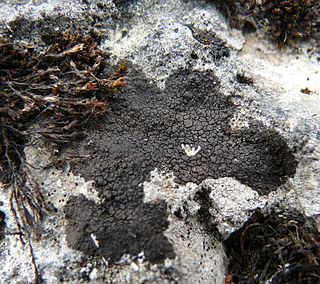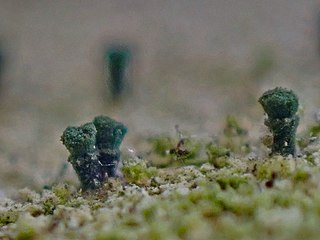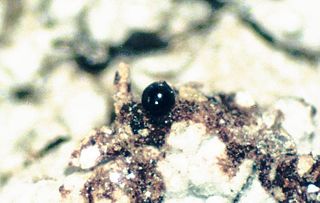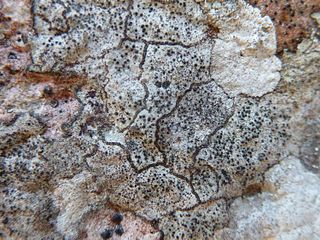
Verrucariaceae is a family of lichens and a few non-lichenised fungi in the order Verrucariales. The lichens have a wide variety of thallus forms, from crustose (crust-like) to foliose (bushy) and squamulose (scaly). Most of them grow on land, some in freshwater and a few in the sea. Many are free-living but there are some species that are parasites on other lichens, while one marine species always lives together with a leafy green alga.

Toninia is a genus of lichen-forming fungi in the family Ramalinaceae.
Clavascidium is a genus of lichens in the family Verrucariaceae. The genus was circumscribed in 1996 by Austrian lichenologist Othmar Breuss. Because the type species of the genus, Clavascidium umbrinum, has been shown using molecular phylogenetics to belong to genus Placidium, Cécile Gueidan and colleagues proposed to unite Clavascidium with Placidium in a 2009 publication. Despite this, the genus has been retained in recent publications of fungal classification.

Catapyrenium is a genus of lichens in the family Verrucariaceae. The genus was circumscribed by German botanist Julius von Flotow in 1850.

Placidiopsis is a genus of lichens in the family Verrucariaceae. The genus was circumscribed by Italian naturalist Francesco Beltramini de Casati in 1858, with Placidiopsis grappae assigned as the type species.
Involucropyrenium is a genus of lichens in the family Verrucariaceae. It has nine species. The genus was circumscribed by Austrian lichenologist Othmar Breuss in 1996, with Involucropyrenium waltheri assigned as the type species.
Henrica is a genus of crustose lichens in the family Verrucariaceae. It has four species. The genus was circumscribed by Maurice Bouly de Lesdain in 1921, with Henrica ramulosa assigned as the type species. The generic name Henrica honours Italian clergyman and lichenologist Joseph-Marie Henry (1870–1947).

Thelidium is a genus of lichen-forming fungi in the family Verrucariaceae. The genus was circumscribed in 1855 by Italian lichenologist Abramo Bartolommeo Massalongo, who assigned Thelidium amylaceum as the type species.

Microcalicium is a genus of lichen-forming fungi in the order Pertusariales. It is the only genus in the monotypic family Microcaliciaceae. These taxa were circumscribed by the Finnish lichenologist Edvard August Vainio in 1927, with Microcalicium disseminatum assigned as the type species.

Tylophoron is a genus of lichen-forming fungi in the family Arthoniaceae. It comprises seven species of crustose lichens, most of which occur in tropical regions.

Sphinctrina is a genus of lichenicolous fungi, usually not lichenized, in the family Sphinctrinaceae. Its species are most commonly parasitic on lichens of the genus Pertusaria.
Arthopyrenia is a genus of fungi in the family Trypetheliaceae. It was formerly classified in the eponymic family Arthopyreniaceae, but molecular phylogenetics studies showed that the type species, Arthopyrenia cerasi, was a member of the Trypetheliaceae.

Bunodophoron is a genus of lichen-forming fungi in the family Sphaerophoraceae. The genus has a broad distribution in the Southern Hemisphere, with several species also present in oceanic regions of the Northern Hemisphere.

Leptorhaphis is a genus of lichens in the family Naetrocymbaceae. Members of the genus Leptorhaphis are commonly called birchbark dot lichens.

Parabagliettoa is a genus of crustose lichens in the family Verrucariaceae. It has 3 species. The genus was circumscribed in 2009 by Cécile Gueidan and Claude Roux, with Parabagliettoa dufourii assigned as the type species.

Hymenelia is a genus of lichen-forming fungi belonging to the family Hymeneliaceae.
Eugeniella is a genus of mostly leaf-dwelling (foliicolous) lichens in the family Pilocarpaceae. It contains 13 species. The genus was circumscribed in 2008 by lichenologists Robert Lücking, Emmanuël Sérusiaux, and Klaus Kalb, with Eugeniella psychotriae assigned as the type species. This lichen was originally called Patellaria psychotriae by Johannes Müller Argoviensis in 1881. The seven species that were initially included in the genus had previously been placed in the genera Bacidia and Byssoloma. Several newly identified species from Australasia and Central and South America were later added. Most of the species grow on leaves, although four of the Australasian species grow on bark.

Polycoccum is a genus of lichenicolous fungi in the family Polycoccaceae. It has about 60 species.
Sporodictyon is a genus of crustose lichens in the family Verrucariaceae. It has 10 species. Most species grow on rocks, although some have been recorded overgrowing soil and mosses.

Hymeneliaceae is a family of lichen-forming fungi in the order Baeomycetales. It contains three genera and about 40 species. The family was circumscribed by German lichenologist Gustav Wilhelm Körber in 1855.














